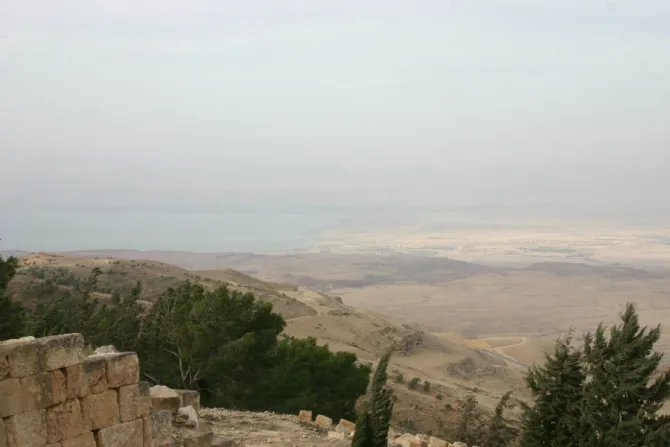Amman, Jordan, Oct 18, 2016 / 23:08 pm
After 10 years of renovations the Memorial Sanctuary of Moses on Mount Nebo has reopened, highlighting the importance of sacred art and holy spaces in the preservation of the faith.
Mount Nebo is where, according to tradition, Moses beheld the Promised Land before his death. The 2,680 foot high ridge is located about 20 miles southwest of Amman, the Jordanian capital, and affords views of the West Bank and Jerusalem.
"Through religious art, men both celebrate their faith and leave a sign of it for future generations," Cardinal Leonardo Sandri, prefect of the Congregation for the Oriental Churches, said at the celebration of the reopening Oct. 15. The cardinal was serving as papal envoy at the event.
"We wish to reaffirm here together the invaluable role of culture and art: they express the nobility of the soul of man of every age. Let us endeavor to commit ourselves to its preservation, especially when it expresses the tending of the human heart towards the Absolute."
He said that "with this gesture, the Holy Father, to whom we turn our grateful thoughts, intends to pay tribute to the importance of this symbolic place, which serves as a crossroads of dialogue and encounter for the three great monotheistic religions, all of which were born in this beloved Middle East."
"The figure of Moses, as a prophet, friend of God and giver of the law, is indeed held in high esteem by our Jewish, Christian and Muslim brothers."
Jordan gained custody of the Holy Land in 1932 thanks to the presence of King Abdullah I, Cardinal Sandri noted. The Franciscans took charge of the ruins excavated by archaeologists from the Studium Biblicum Franciscanum in Jerusalem.
Despite disruptions of war, Cardinal Sandri said the intense work of the decades since then have made it possible to "bring to light the historical and spiritual treasures that this place holds, and which today are returned to Jordan and to humanity in a definitive and renewed installation."
In a time when many treasures of religious history from the region are being looted or destroyed, such as the tomb of the prophet Jonah, Cardinal Sandri expressed his gratitude and appreciation for all those who dedicated themselves to the cause of reopening the memorial.
From Mount Nebo, Cardinal Sandri said, "our gaze reaches to the lands that we inwardly contemplate."
"The Kingdom of Jordan, which, extending its boundaries nearly to this mountain, has become in recent years a place of welcome, hospitality and healing for thousands of refugees and exiles from the suffering lands of Palestine, Syria and Iraq."
The shrine is a place "of healing for souls and bodies, and a place of refuge for all who come here from every part, afflicted in soul and burdened by all manner of bodily suffering," Cardinal Sandri said, quoting a text from the 5th century.
In 1933, on the highest point of the mountain, the remains of a 4th century Byzantine church and monastery commemorating the place of Moses' death, were discovered. The church, designed in the typical style of a basilica, was enlarged in the late 5th century and rebuilt in 597.
Six tombs have been found hollowed in the natural rock beneath the mosaic-covered floor. In the newly opened sanctuary they have preserved remnants of the mosaic floors from different periods, including the earliest of these, which is a panel with a braided cross.
Both St. John Paul II and Benedict XVI visited the site. St. John Paul II visited on March 20, 2000 during his pilgrimage to the Holy Land. As a symbol of peace, he planted an olive tree beside the Byzantine chapel as a symbol of peace.
When Benedict XVI visited the site in 2009 he gave a speech and looked out from the top of the mountain in the direction of Jerusalem.
(Story continues below)
Thinking of the many refugees and exiles from Palestine, Syria, and Iraq, Cardinal Sandri asked that the international community and everyone responsible for peoples, commit to working for peace.
"Namely," he said, "that as Moses contemplated the entrance of the Chosen People to the Promised Land, so also we may see the day soon break, when the promise of reconciliation between peoples will be realized, and a lasting abode of justice and peace will be built."



